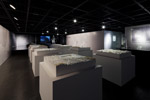| Exhibition Review: |
| Modeling the Past and Future |
| Ken Tadashi Oshima |
| |
In the wake of the Great East Japan Earthquake of March 11, 2011, the world continues to come to grips with the magnitude of its devastation and search for substantial means for the reconstruction and revival of the Tohoku region/Sanriku coast of Japan. The 9.0 magnitude quake, combined with tsunami with heights reaching 40.5 meters and level 7 meltdowns at three reactors at the Fukushima 1 Nuclear Power Plant complex, indeed exceeded all expectations. Beyond the initial shock, paralysis of the nation, and subsequent national campaign for energy saving both for summer cooling and winter heating, the great number of diverse ways that the Disaster affected the physical, cultural, and human landscape remain to be fully comprehended.
The 311:Lost Homes is a powerfully poetic presentation of the Disaster and vital manifestation leading towards recovery. Realized amazingly quickly under the enlightened supervision of Hiroshi Naito and Kenya Hara, the exhibition presents the reconstruction of 14 distinct neighborhoods destroyed in the disaster through 1/500-scale models. The purity of the 1000mm x 1000mm white models atop 850mm podiums are complemented by surrounding wall panels/maps/charts that graphically contextualize the severity of the history-changing event. Each area is presented didactically through small before-and-after aerial photographs to understand what was lost and carefully reconstructed through models: the houses/buildings, landscape/streetscapes and infrastructure including seawalls and telephone poles. The models are rendered completely in white, which serves to both ritually purify each area and unify the many diverse elements that give them their distinct character. The standardized presentation also facilitated the bringing together of the tremendous energy of architecture students from thirteen universities all around Japan, who in the experience of building models could physically fathom the extent of what was lost. While physically rebuilding communities through models, the students from the different universities came to work together to form a larger community of designers and realize the power of their collective energy.
Each modeled area expresses its own unique story in encountering the ravages of nature. The beauty of the Arahama coast on the outskirts of Sendai, with its bands of windbreak pines, low-rise houses, and Edo/Meiji Period Teizan Moat takes on a ghostly appearance knowing that the tsunami wiped out all of the pines and some 800 houses. In Iwate prefecture, Taro-cho’s two-tiered ten-meter-high, 2.4 kilometer long breakwater that took more than a half century to construct proved to be futile in withstanding the forces of the ocean this year despite protecting the area after the 1960 Great Chilean Earthquake. One can certainly appreciate how pleasant the view from Takata Matsubara No. 1 Stadium (Rikuzentakata City, Iwate Prefecture) must have been, adjacent to a seaside park and the Takata Matsubara pine forest. Yet now one also understands its vulnerability as the forest is gone and the stadium is submerged under water. In looking at the model of the village of Namie in Fukushima Prefecture, one may wonder what happened since the before-and-after aerial photos show no discernable change. Yet its caption describing how it is in within the evacuation area around the Fukushima Daiichi Nuclear Plant reveals how it has become a ghost town with no residents.
311 Lost Homes in effect narrates a powerful tale of construction and destruction situated within a precarious balance between natural and human forces. In conjunction with the exhibition, the "311: Thinking from Ground Zero" held at Tokyo University on 2 November 2011 featuring the enlightened discussion by architects including Hiroshi Hara, Toyo Ito, Kengo Kuma and Rikken Yamamoto which can be seen on line: (https://jp.toto.com/gallerma/ex111102/sympsm_e.htm) Through the 311 exhibition, TOTO GALLERY・MA shows how it is a platform for architects, students, and society at large to come together and galvanize efforts such as those of ArchiAid to both reflect on the power of the built environment and contemplate its future.
In building models of the "lost homes," the students came to understand the buildings that have been lost, and most importantly the many elements required to construct a community. Such first-hand knowledge and experience will be indeed invaluable in post 311 rebuilding to sustain the lives of future generations.
|
|
 |

|
Exhibition space
©Fujitsuka Mitsumasa |
 |

|
Model: Taro-cho, Miyako City, Kamaishi, Iwate Prefecture
©Fujitsuka Mitsumasa |
 |

|
Model: Rikuzentakata, Rikuzentakata City, Iwate Prefecture
©Fujitsuka Mitsumasa |
|